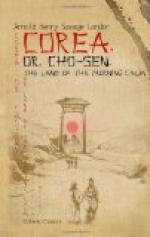In summer time the windows and doors are kept open, or even removed altogether during the day-time, and then, in order to preserve that privacy of which every Corean is so proud, recourse is had to a capital dodge. At the end of the projecting roof, and immediately in front of the window or entrance, at the distance of a couple of feet, is hung a shade in the shape of a fine mat, made of numberless long strings of split bamboo, tied together in a parallel position by several silk strings which vary in number with the size of the mat. The use of these curtain-like barriers has several advantages. They protect the house from those troublesome visitors the flies; they let in the air, though not the sun, and, while the people who are in the house can plainly see through them what goes on in the street, no one on the outside can distinguish either those inside, or what is doing in the house. Good mats are very expensive, and difficult to obtain; therefore, it is only the better classes that can use them. Poorer folk are satisfied with very rough mats of rushes. It is also the custom for good citizens of the provinces to send the king at the New Year presents of a certain number of these mats, which, like the Indian shawls of Her Britannic Majesty, are given out again by him to the royal princes and highest officials. I was fortunate enough to be presented with two of these blinds by a high official, who was closely related to the king. They are a marvel of patient and careful work, as accurately and delicately done as if some machine had been employed. They are nearly six feet high, by five wide, and are yellow in colour with black, red, and green stripes painted at the top and bottom. In the centre is a very pretty, simple frieze, on the inside of which are some Corean characters.
If a Corean house does not look very inviting when you look at it from the outside, still less does it when you are indoors. The smallness of the rooms and their lack of furniture, pictures, or ornaments are features not very pleasant to the eye. The rooms are like tiny boxes, between eight and ten feet long, less than this in width and about seven feet high. They are white all over with the exception of the floor, which is covered with thick, yellowish oil-paper. The poorest kind of Corean house consists of only a single room; the abode of the moderately well-off man, on the other hand, may have two or three, generally three rooms; though, of course, the houses of very high offices are found with a still larger number.
The Corean process of heating the houses is somewhat original. It is a process used in a great part of Eastern Asia—and, to my mind, it is the only thoroughly barbaric custom which the Corean natives have retained. The flooring of the rooms consists of slabs of stone, under which is a large oven of the same extent as the room overhead, which oven, during the winter, is filled with a burning wood-fire, which is kept up day and night. What happens is generally this: The coolie whose duty it is to look after this oven, to avoid trouble fills it with wood and dried leaves up to the very neck, and sets these on fire and then goes to sleep; by which means the stone slabs get heated to such an extent that, sometimes, notwithstanding the thick oil paper which covers them, one cannot stand on them with bare feet.




